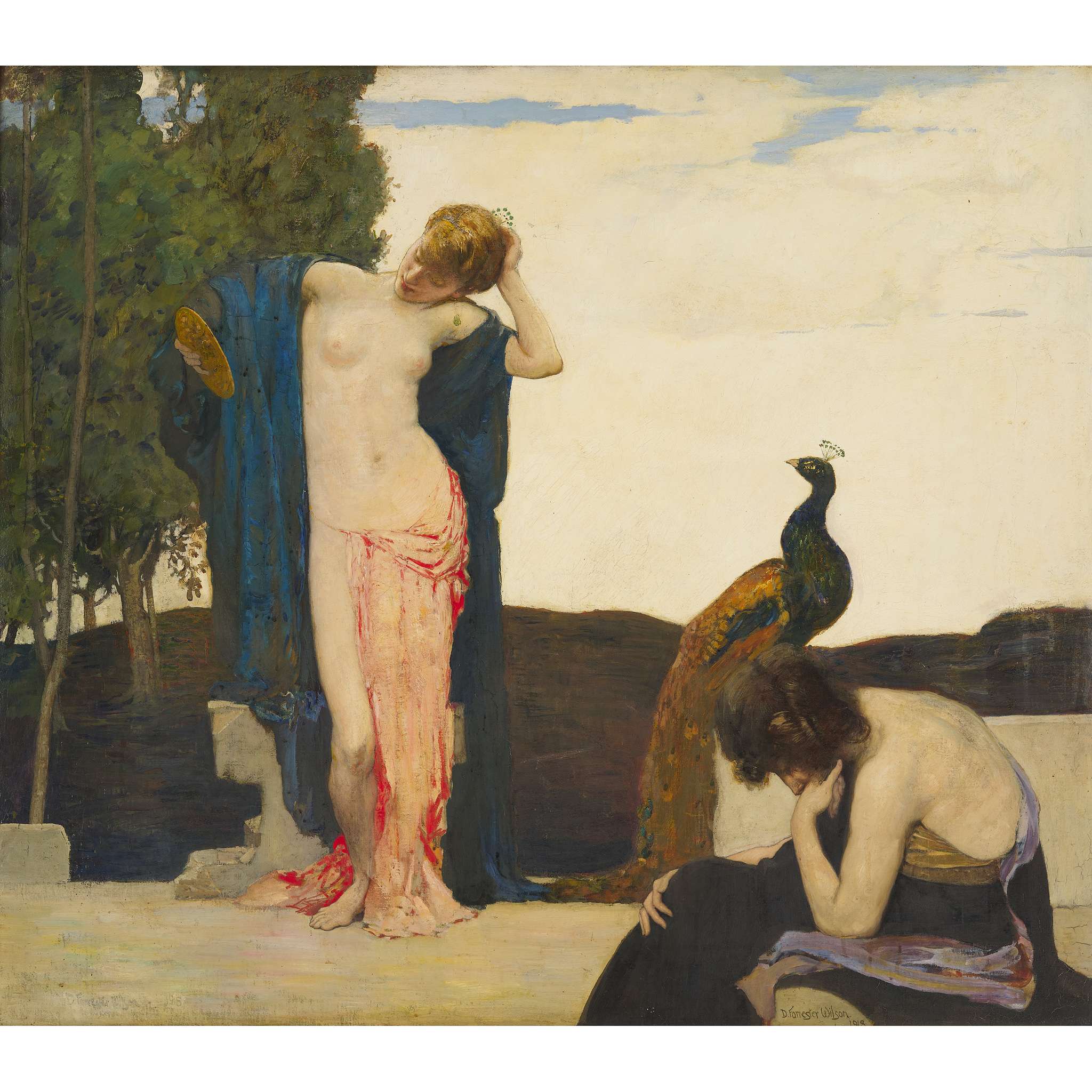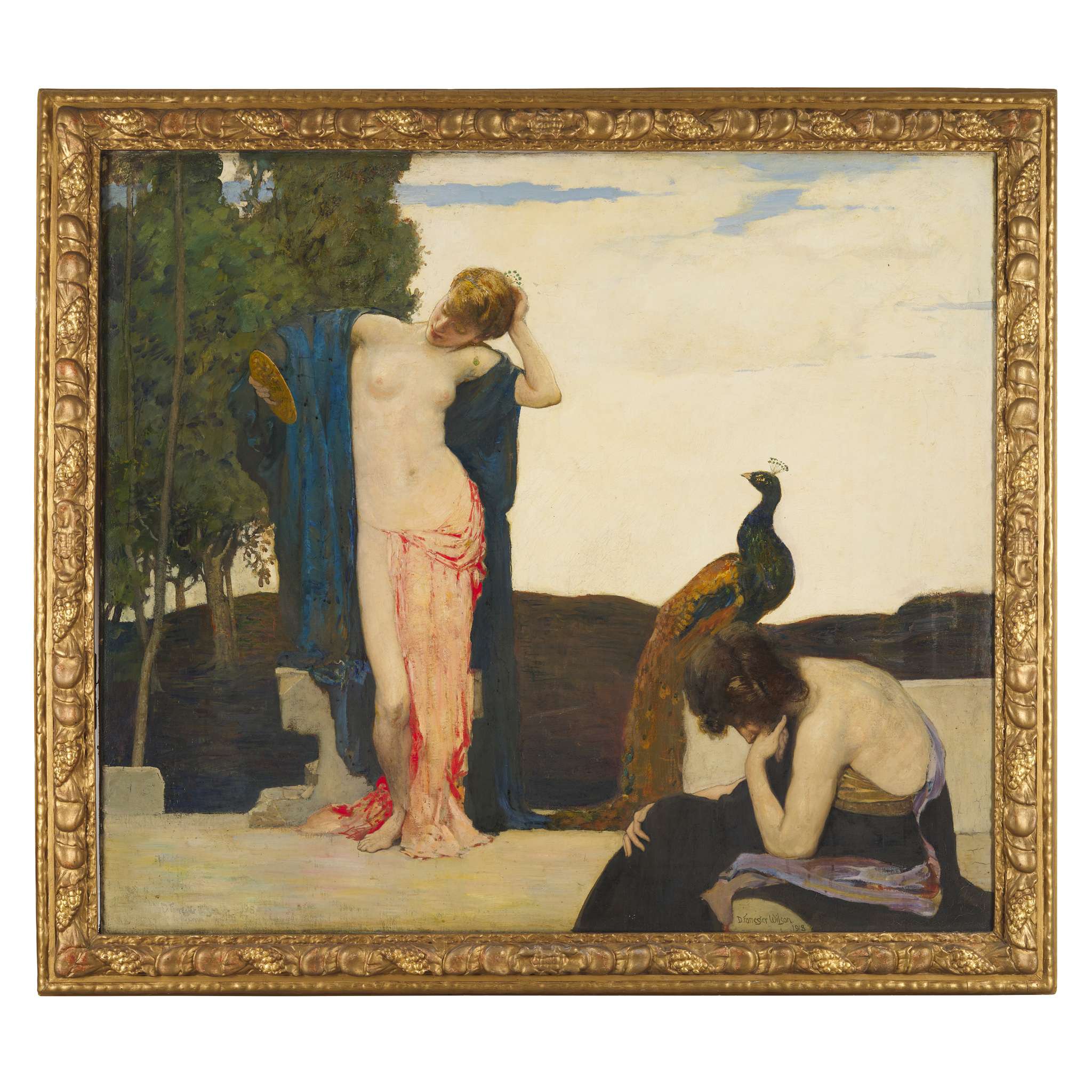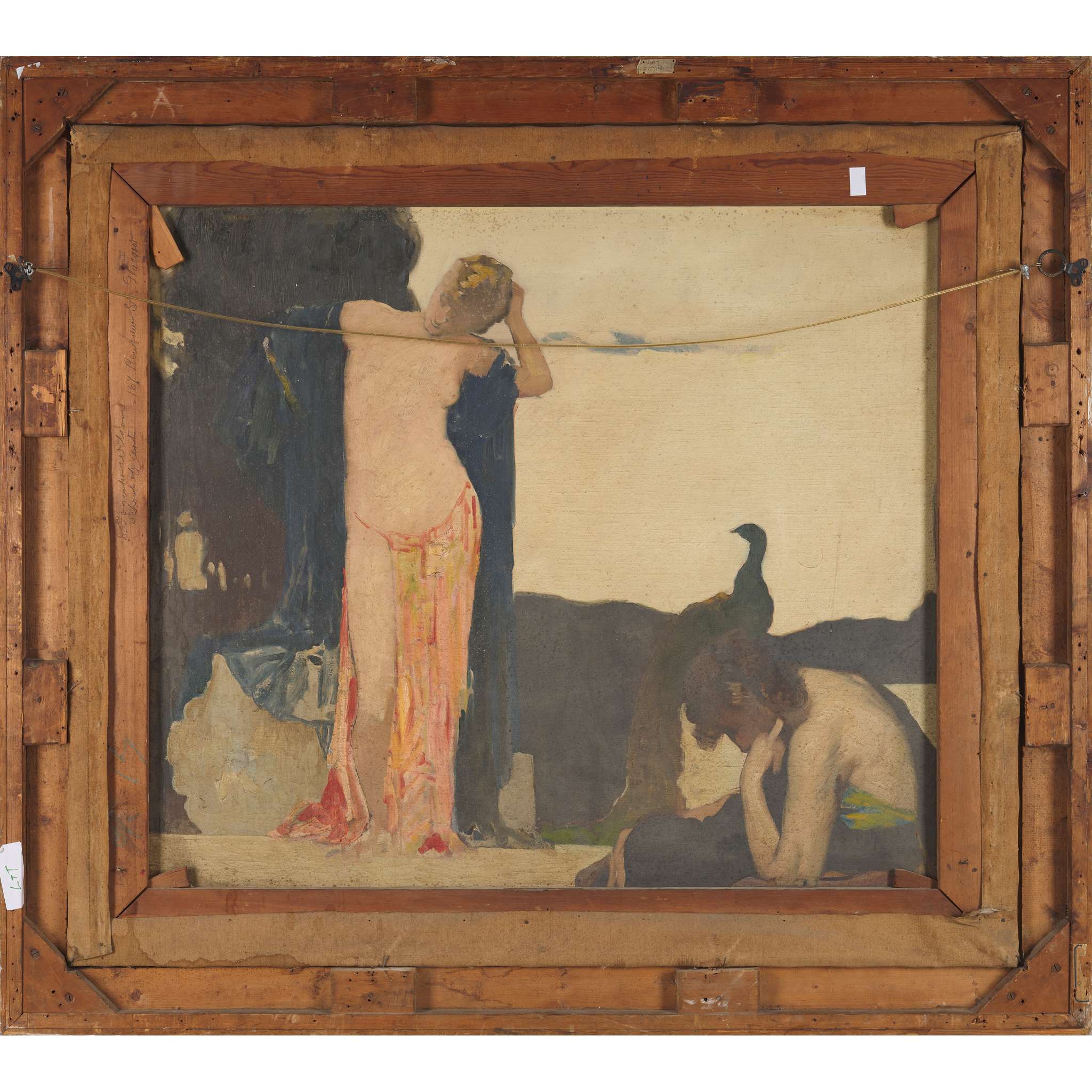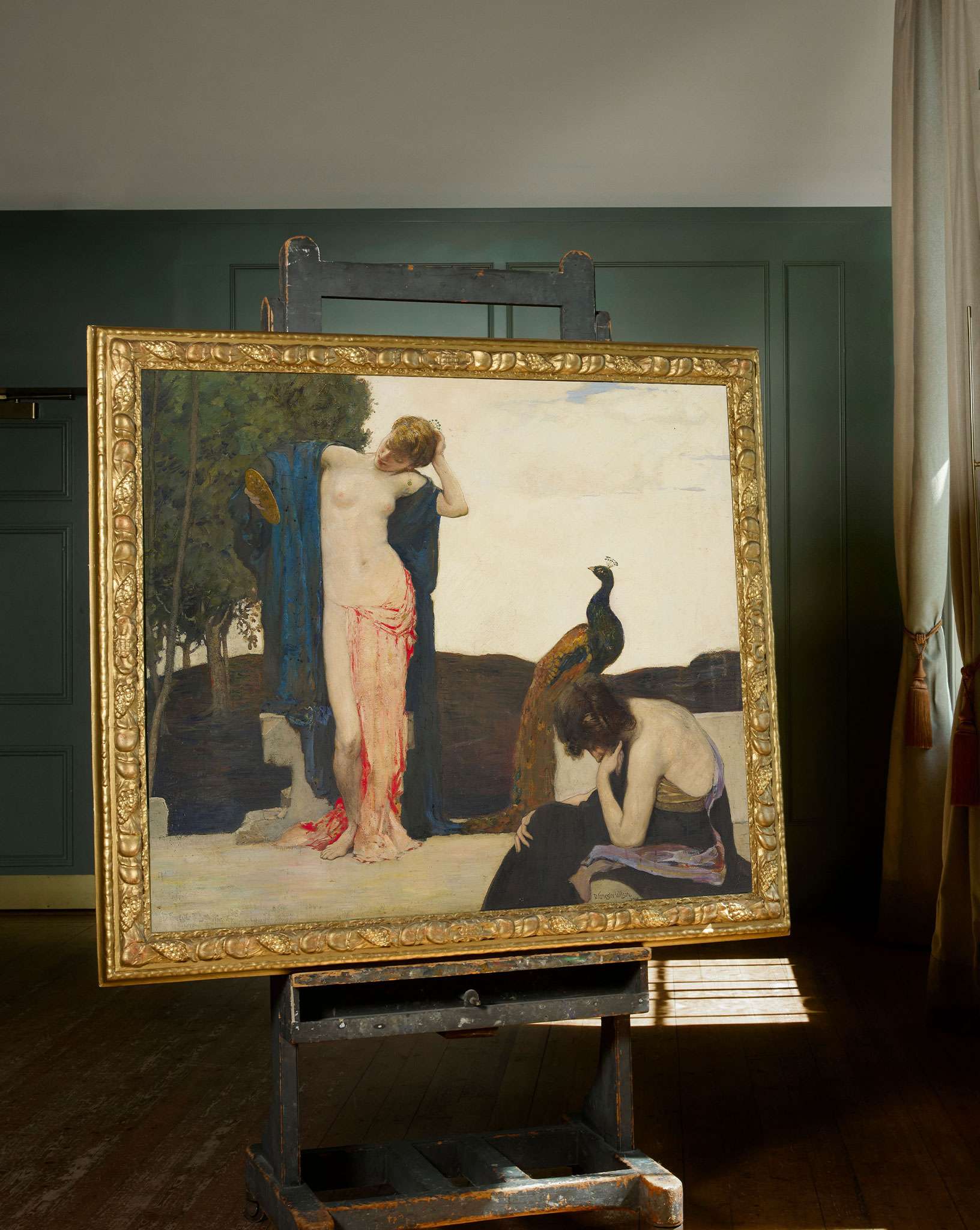154
DAVID FORRESTER WILSON R.S.A. (SCOTTISH 1873-1950)
VANITY
Signed and dated 1918 twice, inscribed to stretcher verso ‘Forrester Wilson, School of Art, 167 Renfrew St, Glasgow’, with a preliminary sketch verso, oil on canvas
115cm x 130cm (43.25in x 51.25in)
Exhibited:Royal Scottish Academy, Edinburgh, 1919, no.125
David Forrester Wilson is a difficult artist to pin down. In recent years, his name has become, rather surprisingly, associated with the great Pop Art icon Andy Warhol, who it turns out was a great fan of his work and owned a selection of his paintings. They were included in the auction of the artist’s personal collection in 1988 and one particularly Symbolist composition, The Wind, which had been displayed prominently at The Factory, went on to achieve $110,000, ten times its pre-sale estimate. Vanity allows comparisons to this work in its rich celebration of beauty, colour and sensuality - quite at odds with the more naturalistic landscapes that Forrester Wilson also produced in his career.Despite the evocative nature of his Symbolist paintings and the rather eclectic nature of his contemporary collectors, Forrester Wilson himself lived a very stable existence, living in Milngavie, Ayr, the city of Glasgow and ultimately Islay over the course of his life, as he painted, exhibited and taught. The son of a lithographer, Forrester Wilson trained at the Glasgow School of Art and travelled in Europe, as advised by his teachers to develop his practice, before ultimately joining the teaching staff, working under Maurice Greiffenhagen and eventually succeeding him on his retirement (see Lot 150). Forrester Wilson looked to a wide range of artists for inspiration, from his original teacher the Belgian Symbolist painter Jean Deville to his Scottish predecessors, the Glasgow Boys, including James Guthrie and John Lavery, as well as his contemporaries, including The Four: Charles Rennie Mackintosh, Frances and Margaret Macdonald and Herbert MacNair. Forrester Wilson was also influenced by the work of artists including J.M. Whistler and Jules Bastien-Lepage and this open-mindedness is evidence of his own desire to evolve and learn, both in his own practice and as he taught the next generation.The artist was committed to exhibiting his work and made regular submissions to both the Royal Scottish Academy in Edinburgh and the Royal Glasgow Institute, as well as exhibiting internationally in Chicago and Pittsburgh, U.S.A. Throughout the 1920s Forrester Wilson exhibited a number of works with poetic titles that evoked concepts, sounds and sensations, rather than a particular subject or narrative, aligning with the broader ideals of the wider Symbolist movement. A reaction against previously prevailing naturalist and realistic depictions of the world, Symbolist works were concerned more with feeling and atmosphere, conveying emotion across art, poetry and literature. It is maybe not surprising that this was painted in 1918, when beautiful allegorial scenes offered a means for viewers to escape to a haven outside of their time. Forrester Wilson underpins the dramatic composition with skilled drawing and design, taking his life school talent out of an academic context and into the creation of this mysterious and languid scene. Classical elements are present, as well as rich colour, drawing us into this unspecified locale of light skies, dense trees and pale stone, where there is a sense of leisure and idleness in the expanse of pale skin, lush, draping fabrics and the presence of a majestic peacock, its extravagant tail just temporarily at rest. The word ‘vanity’ is defined as ‘an excess of pride in one’s appearance or achievements’. The distinctive crest of feathers on the peacock’s head, known as the crown, is also found on the head of the standing nude, who gazes at their own reflection in the mirror. This invites us to identify the nude, too, as a ‘Peacock’, synonymous with vanity or showy behaviour to attract attention or impress. This simile also alludes to the male peacock, with its colourful tail that can be expanded like a fan, which has long symbolized vanity and pride. In the Greek myth of Narcissus, a beautiful youth is cursed by the goddess Nemesis for his vanity. He falls in love with his own reflection in a pool of water, becoming so obsessed that he wastes away from thirst and eventually transforms into the narcissus flower. This myth cautions against self-obsession and the dangers of prioritizing vanity over human empathy. This very dynamic might explain the distance between the two figures, the sitting figure’s subdued posture and her isolation from the self-obsessed nude.
VANITY
Signed and dated 1918 twice, inscribed to stretcher verso ‘Forrester Wilson, School of Art, 167 Renfrew St, Glasgow’, with a preliminary sketch verso, oil on canvas
115cm x 130cm (43.25in x 51.25in)
Exhibited:Royal Scottish Academy, Edinburgh, 1919, no.125
David Forrester Wilson is a difficult artist to pin down. In recent years, his name has become, rather surprisingly, associated with the great Pop Art icon Andy Warhol, who it turns out was a great fan of his work and owned a selection of his paintings. They were included in the auction of the artist’s personal collection in 1988 and one particularly Symbolist composition, The Wind, which had been displayed prominently at The Factory, went on to achieve $110,000, ten times its pre-sale estimate. Vanity allows comparisons to this work in its rich celebration of beauty, colour and sensuality - quite at odds with the more naturalistic landscapes that Forrester Wilson also produced in his career.Despite the evocative nature of his Symbolist paintings and the rather eclectic nature of his contemporary collectors, Forrester Wilson himself lived a very stable existence, living in Milngavie, Ayr, the city of Glasgow and ultimately Islay over the course of his life, as he painted, exhibited and taught. The son of a lithographer, Forrester Wilson trained at the Glasgow School of Art and travelled in Europe, as advised by his teachers to develop his practice, before ultimately joining the teaching staff, working under Maurice Greiffenhagen and eventually succeeding him on his retirement (see Lot 150). Forrester Wilson looked to a wide range of artists for inspiration, from his original teacher the Belgian Symbolist painter Jean Deville to his Scottish predecessors, the Glasgow Boys, including James Guthrie and John Lavery, as well as his contemporaries, including The Four: Charles Rennie Mackintosh, Frances and Margaret Macdonald and Herbert MacNair. Forrester Wilson was also influenced by the work of artists including J.M. Whistler and Jules Bastien-Lepage and this open-mindedness is evidence of his own desire to evolve and learn, both in his own practice and as he taught the next generation.The artist was committed to exhibiting his work and made regular submissions to both the Royal Scottish Academy in Edinburgh and the Royal Glasgow Institute, as well as exhibiting internationally in Chicago and Pittsburgh, U.S.A. Throughout the 1920s Forrester Wilson exhibited a number of works with poetic titles that evoked concepts, sounds and sensations, rather than a particular subject or narrative, aligning with the broader ideals of the wider Symbolist movement. A reaction against previously prevailing naturalist and realistic depictions of the world, Symbolist works were concerned more with feeling and atmosphere, conveying emotion across art, poetry and literature. It is maybe not surprising that this was painted in 1918, when beautiful allegorial scenes offered a means for viewers to escape to a haven outside of their time. Forrester Wilson underpins the dramatic composition with skilled drawing and design, taking his life school talent out of an academic context and into the creation of this mysterious and languid scene. Classical elements are present, as well as rich colour, drawing us into this unspecified locale of light skies, dense trees and pale stone, where there is a sense of leisure and idleness in the expanse of pale skin, lush, draping fabrics and the presence of a majestic peacock, its extravagant tail just temporarily at rest. The word ‘vanity’ is defined as ‘an excess of pride in one’s appearance or achievements’. The distinctive crest of feathers on the peacock’s head, known as the crown, is also found on the head of the standing nude, who gazes at their own reflection in the mirror. This invites us to identify the nude, too, as a ‘Peacock’, synonymous with vanity or showy behaviour to attract attention or impress. This simile also alludes to the male peacock, with its colourful tail that can be expanded like a fan, which has long symbolized vanity and pride. In the Greek myth of Narcissus, a beautiful youth is cursed by the goddess Nemesis for his vanity. He falls in love with his own reflection in a pool of water, becoming so obsessed that he wastes away from thirst and eventually transforms into the narcissus flower. This myth cautions against self-obsession and the dangers of prioritizing vanity over human empathy. This very dynamic might explain the distance between the two figures, the sitting figure’s subdued posture and her isolation from the self-obsessed nude.
Scottish Paintings & Sculpture
Sale Date(s)
Venue Address
All collections are by appointment only (this applies to both carriers and personal collections).
To book or for more information contact info@lyonandturnbull.com or telephone 0131 557 8844.
-----
UK & International - Smaller items and paintings
Art & Antique Delivery Centre
Mail Boxes Etc.
12 South Bridge
Edinburgh, EH1 1DD
T: 0131 556 6226
info@mbeedinburgh.com
Mailboxes Etc
8 Shepherd Market
Mayfair
London, W1J 7JY
Tel: 0207 491 0022
info@mbemayfair.co.uk
Mailboxes Etc
61 Praed Street
London, W2 1NS
Tel: 0207 706 3666
info@mbepaddington.co.uk
Pack & Send Edinburgh East
53 Elm Row
Leith Walk
Edinburgh, EH7 4AH
Tel: 0131 201 2244
edinburgheast@packsend.co.uk
www.packsend.co.uk/edinburgheast
UK - Larger Items
Aardvark Art Services Ltd
Tel: 01253 794 673
info@aardvarkartservices.com
John McVey Distribution Storage & Transport (UK & Ireland)
175 Waddell Street
Drumchapel
Glasgow
G5 0NA
+44(0)141 429 2015
UK & International - Larger Items
Stephen Morris Shipping
Unit 15, Ockham Drive
Greenford, Middlesex
UB6 0FD
+44(0)20 8832 2222
hannah@shipsms.co.uk
Crown Fine Art
Art Central, Union Court
20-22 Union Road
London, SW4 6JP
+44 (0)20 7732 7610
auctionteam.uk@crownww.com
Constantine Moving Services (Specialists in UK & International Shipping)
Constantine House
North Caldeen Road
Coatbridge, ML5 4EF
Tel: 01236 430 681
allanak@constantinemoving.com
A Van Man Transport
Unit 5, Benridge Park
Holyrood Close, Creekmoor
Poole, Dorset, BH17 7BD
Tel: 01202 600 012
office@avmt.co.uk
Gallery Support Group
Unit 4, 89 Manor Farm Road
Wembley
London, HA0 1BA
Tel: 020 305 307 53
info@gallerysupportgroup.com
Important Information
A £6,500 spend limit has been applied to this auction. Bidders intending on spending above this amount will need to provide photo identification to have the spend limit removed. To help manage this, you will be asked to confirm your projected spend as part of the auction registration process. You may receive a request to provide photo ID. We ask that you provide this at your earliest convenience on request, to ensure you are free to bid above the £6,500 spend limit on sale day . Please note it is Lyon and Turnbull’s discretion to ask for identification – you will be also asked to provide this if you have no bidding history.
BUYER'S PREMIUM
The buyer shall pay the hammer price together with a premium, at the following rate, thereon.
26% up to £20,000
25% from £20,001 to £500,000
20% thereafter
VAT will be charged on the premium at the rate imposed by law (see our Conditions of Sale at the back of this catalogue).
ADDITIONAL VAT
† VAT at the standard rate payable on the hammer price
‡ Reduced rate of 5% import VAT payable on the hammer price
[Ω] Standard rate of import VAT on the hammer price
Lots affixed with ‡ or [Ω] symbols may be subject to further regulations upon export /import, please see Conditions of Sale for Buyers Section D.2.
No VAT is payable on the hammer price or premium for books bought at auction
REGISTRATION
All potential buyers must register prior to placing a bid. Paddle registration must be completed in advance of the sale day. Please note that all first-time, and those returning after an extended period, bidders at Lyon & Turnbull will be asked to supply the following documents in order to facilitate registration:
1 – Government issued photo ID (Passport/Driving licence)
2 – Proof of address (utility bill/bank statement).
By registering for the sale, the buyer acknowledges that he or she has read, understood and accepted our Conditions of Sale.
ARTIST’S RESALE ROYALTY (DROIT DE SUITE)
This symbol § indicates works which may be subject to the Droit de Suite or Artist’s Resale Right, which took effect in the United Kingdom on 14th February 2006. We are required to collect a royalty payment for all qualifying works of art. Under new legislation which came into effect on 1st January 2012 this applies to living artists and artists who have died in the last 70 years. This royalty will be charged to the Buyer on the Hammer Price and in addition to the Buyer’s Premium. It will not apply to works where the Hammer Price is less than £1,000. The charge for works of art sold at and above £1,000 and below £50,000 is 4%. For items selling above £50,000, charges are calculated on a sliding scale. All royalty charges are paid to the Design and Artists Copyright Society (‘DACS’) and no handling costs or additional fees are retained by the Auctioneer. Resale royalties are not subject to VAT. Please note that the royalty payment is calculated on the rate of exchange at the European Central Bank on the date of the sale. More information on Droit de Suite is available at www.dacs.org.uk.
REMOVAL OF PURCHASES
Responsibility for packing, shipping and insurance shall be exclusively that of the purchaser. See Collections & Storage section for more info specific to this particular auction.
CATALOGUE DESCRIPTIONS
All item descriptions, dimensions and estimates are provided for guidance only. It is the buyer’s responsibility to inspect all lots prior to bidding to ensure that the condition is to their satisfaction. Our specialists will be happy to prepare condition reports and additional images. These are for guidance only and all lots are sold ‘as found’, as per our Conditions of Sale.
IMPORT/EXPORT
Prospective buyers are advised that several countries prohibit the importation of property containing materials from endangered species, including but not limited to; rosewood, rhino horn, ivory, coral and tortoiseshell. Accordingly, prospective buyers should familiarise themselves with all relevant customs regulations prior to bidding if they intend to import lots to another country. It is the buyer’s sole responsibility to obtain any relevant export or import licence. The denial of any licence or any delay in obtaining licences shall neither justify the recession of any sale nor any delay in making full payment for the lot.
ENDANGERED SPECIES
Please be aware that lots marked with the symbol Y contain material which may be subject to CITES regulations when exporting outside Great Britain. For more information visit https://www.defra.gov.uk/ahvla-en/imports-exports/cites
Terms & Conditions
UK - Conditions Of Sale For Buyers
These Conditions of Sale and the Saleroom Notices as well as specific Catalogue terms, set out the terms on which we offer the Lots listed in this Catalogue for sale. By registering to bid and/or by bidding at auction You agree to these terms, we recommend that You read them carefully before doing so. You will find a list of definitions and a glossary at the end providing explanations for the meanings of the words and expressions used.
Special terms may be used in Catalogue descriptions of particular classes of items (Books, Jewellery, Paintings, Guns, Firearms, etc.) in which case the descriptions must be interpreted in accordance with any glossary appearing in the Catalogue. These notices and terms will also form part of our terms and conditions of sales.
In these Conditions the words “Us”, “Our”, “We” etc. refers to Lyon & Turnbull Ltd, the singular includes the plural and vice versa as appropriate. “You”, “Your” means the Buyer.
Lyon & Turnbull Ltd. acts as agent for the Seller. On occasion where Lyon & Turnbull Ltd. own a lot in part or full the property will be identified in the catalogue with the symbol (















